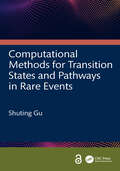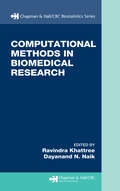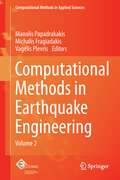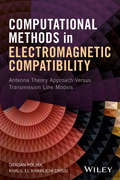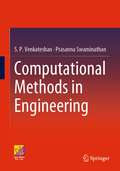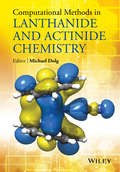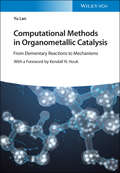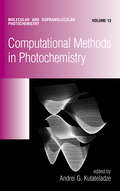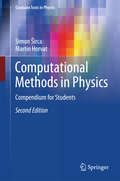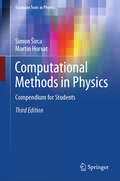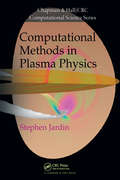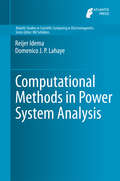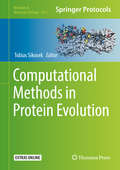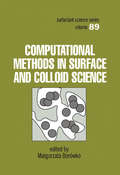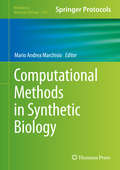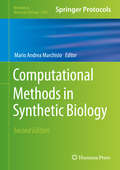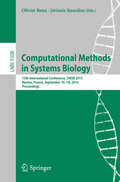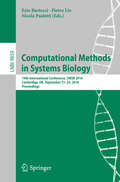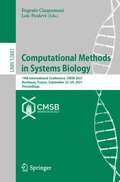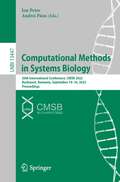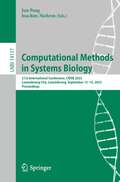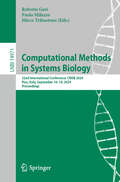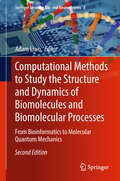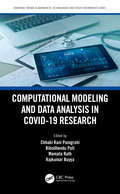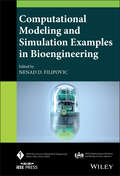- Table View
- List View
Computational Methods for Transition States and Pathways in Rare Events
by Shuting GuBased on the calculation of transition states and the identification of transition paths, this book aims to provide a comprehensive guide to understanding and simulating rare events.The author introduces both fundamental concepts of transition states and pathways and advanced computational techniques, focusing on Gentlest Ascent Dynamics (GAD) and its variants. In particular, she explores enhanced numerical methods such as the convex splitting method and the Scalar Auxiliary Variable (SAV) approach within the Iterative Minimization Formulation (IMF). In addition, the book applies these methods to real-world problems, highlighting the string method and the geometric Minimum Action Method (gMAM) for computing transition paths.The book is written for researchers and practitioners in fields such as applied mathematics, physics, chemistry, and computational science who are interested in the underlying mechanisms of rare events and their transition processes.Chapters 3 and 4 of this book are each freely available as a downloadable Open Access PDF at http://www.taylorfrancis.com under a Creative Commons Attribution-Non Commercial-No Derivatives (CC-BY-NC-ND) 4.0 license.
Computational Methods in Biomedical Research
by Ian MuehlenhausContinuing advances in biomedical research and statistical methods call for a constant stream of updated, cohesive accounts of new developments so that the methodologies can be properly implemented in the biomedical field. Responding to this need, Computational Methods in Biomedical Research explores important current and emerging computatio
Computational Methods in Earthquake Engineering: Volume 2 (Computational Methods in Applied Sciences #30)
by Manolis Papadrakakis Michalis Fragiadakis Vagelis PlevrisThis book provides an insight on advanced methods and concepts for the design and analysis of structures against earthquake loading. This second volume is a collection of 28 chapters written by leading experts in the field of structural analysis and earthquake engineering. Emphasis is given on current state-of-the-art methods and concepts in computing methods and their application in engineering practice. The book content is suitable for both practicing engineers and academics, covering a wide variety of topics in an effort to assist the timely dissemination of research findings for the mitigation of seismic risk. Due to the devastating socioeconomic consequences of seismic events, the topic is of great scientific interest and is expected to be of valuable help to scientists and engineers. The chapters of this volume are extended versions of selected papers presented at the COMPDYN 2011 conference, held in the island of Corfu, Greece, under the auspices of the European Community on Computational Methods in Applied Sciences (ECCOMAS).
Computational Methods in Electromagnetic Compatibility: Antenna Theory Approach Versus Transmission Line Models
by Dragan Poljak Khalil El DrissiOffers a comprehensive overview of the recent advances in the area of computational electromagnetics Computational Method in Electromagnetic Compatibility offers a review of the most recent advances in computational electromagnetics. The authors—noted experts in the field—examine similar problems by taking different approaches related to antenna theory models and transmission line methods. They discuss various solution methods related to boundary integral equation techniques and finite difference techniques. The topics covered are related to realistic antenna systems including antennas for air traffic control or ground penetrating radar antennas; grounding systems (such as grounding systems for wind turbines); biomedical applications of electromagnetic fields (such as transcranial magnetic stimulation); and much more. The text features a number of illustrative computational examples and a reference list at the end of each chapter. The book is grounded in a rigorous theoretical approach and offers mathematical details of the formulations and solution methods. This important text: Provides a trade-off between a highly efficient transmission line approach and antenna theory models providing analysis of high frequency and transient phenomena Contains the newest information on EMC analysis and design principles Discusses electromagnetic field coupling to thin wire configurations and modeling in bioelectromagnetics Written for engineering students, senior researchers and practicing electrical engineers, Computational Method in Electromagnetic Compatibility provides a valuable resource in the design of equipment working in a common electromagnetic environment.
Computational Methods in Engineering
by S. P. Venkateshan Prasanna SwaminathanThe book is designed to serve as a textbook for courses offered to graduate and upper-undergraduate students enrolled in mechanical engineering. The book attempts to make students with mathematical backgrounds comfortable with numerical methods. The book also serves as a handy reference for practicing engineers who are interested in applications. The book is written in an easy-to-understand manner, with the essence of each numerical method clearly stated. This makes it easy for professional engineers, students, and early career researchers to follow the material presented in the book. The structure of the book has been modeled accordingly. It is divided into four modules: i) solution of a system of equations and eigenvalues which includes linear equations, determining eigenvalues, and solution of nonlinear equations; ii) function approximations: interpolation, data fit, numerical differentiation, and numerical integration; iii) solution of ordinary differential equations—initial value problems and boundary value problems; and iv) solution of partial differential equations—parabolic, elliptic, and hyperbolic PDEs. Each section of the book includes exercises to reinforce the concepts, and problems have been added at the end of each chapter. Exercise problems may be solved by using computational tools such as scientific calculators, spreadsheet programs, and MATLAB codes. The detailed coverage and pedagogical tools make this an ideal textbook for students, early career researchers, and professionals.
Computational Methods in Lanthanide and Actinide Chemistry
by Michael DolgThe f-elements and their compounds often possess an unusually complex electronic structure, governed by the high number of electronic states arising from open f-shells as well as large relativistic and electron correlation effects. A correct theoretical description of these elements poses the highest challenges to theory. Computational Methods in Lanthanide and Actinide Chemistry summarizes state-of-the-art electronic structure methods applicable for quantum chemical calculations of lanthanide and actinide systems and presents a broad overview of their most recent applications to atoms, molecules and solids. The book contains sixteen chapters, written by leading experts in method development as well as in theoretical investigations of f-element systems. Topics covered include: * Relativistic configuration interaction calculations for lanthanide and actinide anions * Study of actinides by relativistic coupled cluster methods * Relativistic all-electron approaches to the study of f- element chemistry * Relativistic pseudopotentials and their applications * Gaussian basis sets for lanthanide and actinide elements * Applied computational actinide chemistry This book will serve as a comprehensive reference work for quantum chemists and computational chemists, both those already working in, and those planning to enter the field of quantum chemistry for f-elements. Experimentalists will also find important information concerning the capabilities of modern quantum chemical methods to assist in the interpretation or even to predict the outcome of their experiments.
Computational Methods in Organometallic Catalysis: From Elementary Reactions to Mechanisms
by Yu LanThe book includes a historical introduction to organometallic chemistry, a survey of mechanisms, and an extensive introduction to quantum mechanical computational methods.
Computational Methods in Photochemistry
by Andrei G. KutateladzeAddressing critical aspects of computational modeling in photochemistry, Molecular Methods in Photochemistry is designed to familiarize researchers and practitioners with state-of-the-art computational methods to predict the reactivity of excited molecules. It provides practical guidelines and examples for the modeling of excited states and describ
Computational Methods in Physics: Compendium for Students (Graduate Texts in Physics)
by Martin Horvat Simon ŠircaThis book is intended to help advanced undergraduate, graduate, and postdoctoral students in their daily work by offering them a compendium of numerical methods. The choice of methods pays significant attention to error estimates, stability and convergence issues, as well as optimization of program execution speeds. Numerous examples are given throughout the chapters, followed by comprehensive end-of-chapter problems with a more pronounced physics background, while less stress is given to the explanation of individual algorithms. The readers are encouraged to develop a certain amount of skepticism and scrutiny instead of blindly following readily available commercial tools. The second edition has been enriched by a chapter on inverse problems dealing with the solution of integral equations, inverse Sturm-Liouville problems, as well as retrospective and recovery problems for partial differential equations. The revised text now includes an introduction to sparse matrix methods, the solution of matrix equations, and pseudospectra of matrices; it discusses the sparse Fourier, non-uniform Fourier and discrete wavelet transformations, the basics of non-linear regression and the Kolmogorov-Smirnov test; it demonstrates the key concepts in solving stiff differential equations and the asymptotics of Sturm-Liouville eigenvalues and eigenfunctions. Among other updates, it also presents the techniques of state-space reconstruction, methods to calculate the matrix exponential, generate random permutations and compute stable derivatives.
Computational Methods in Physics: Compendium for Students (Graduate Texts in Physics)
by Martin Horvat Simon ŠircaThis textbook provides a compendium of numerical methods to assist physics students and researchers in their daily work. It carefully considers error estimates, stability and convergence issues, the choice of optimal methods, and techniques to increase program execution speeds. The book supplies numerous examples throughout the chapters that are concluded by more comprehensive problems with a strong physics background. Instead of uncritically employing modern black-box tools, the readers are encouraged to develop a more ponderous and skeptical approach. This revised and expanded edition now includes a new chapter on numerical integration and stable differentiation, as well as fresh material on optimal filtering, integration of gravitational many-body problems, computation of Poincaré maps, regularization of orbits, singular Sturm-Liouville problems, techniques for time evolution and spatial treatment of (semi)infinite domains in spectral methods, and phase retrieval. It also brings updated discussions of algebraic problems involving sparse matrices and of high-resolution schemes for partial differential equations.
Computational Methods in Plasma Physics (Chapman & Hall/CRC Computational Science)
by Stephen JardinAssuming no prior knowledge of plasma physics or numerical methods, Computational Methods in Plasma Physics covers the computational mathematics and techniques needed to simulate magnetically confined plasmas in modern magnetic fusion experiments and future magnetic fusion reactors. Largely self-contained, the text presents the basic concepts neces
Computational Methods in Power System Analysis (Atlantis Studies in Scientific Computing in Electromagnetics #1)
by Reijer Idema Domenico J.P. LahayeThis book treats state-of-the-art computational methods for power flow studies and contingency analysis. In the first part the authors present the relevant computational methods and mathematical concepts. In the second part, power flow and contingency analysis are treated. Furthermore, traditional methods to solve such problems are compared to modern solvers, developed using the knowledge of the first part of the book. Finally, these solvers are analyzed both theoretically and experimentally, clearly showing the benefits of the modern approach.
Computational Methods in Protein Evolution (Methods in Molecular Biology #1851)
by Tobias SikosekThis volume presents a diverse collection of methodologies used to study various problems at the protein sequence and structure level. The chapters in this book look at issues ranging from broad concepts like protein space to specifics like antibody modeling. Topics include point mutations, gene duplication, de novo emergence of new genes, pairwise correlated mutations, ancestral protein reconstruction, homology modelling, protein stability and dynamics, and protein-protein interactions. The book also covers a wide range of computational approaches, including sequence and structure alignments, phylogenies, physics-based and mathematical approaches, machine learning, and more. Written in the highly successful Methods in Molecular Biology series format, chapters include introductions to their respective topics, lists of the necessary materials and prerequisites, step-by-step, readily reproducible computational protocols (using command line or graphical user interfaces, sometimes including computer code), and tips on troubleshooting and avoiding known pitfalls.Cutting-edge and authoritative, Computational Methods in Protein Evolution is a valuable resource that offers useful workflows and techniques that will help both novice and expert researchers working with proteins computationally.
Computational Methods in Surface and Colloid Science (Surfactant Science)
by Małgorzata BorówkoThis volume presents computer simulation methods and mathematical modelling of physical processes used in surface science research. It offers in-depth analysis of advanced theoretical approaches to behaviours of fluids in contact with porous, semiporous and nonporous solid surfaces. The book also explores interfacial systems for a wide variety of p
Computational Methods in Synthetic Biology (Methods in Molecular Biology #1244)
by Mario Andrea MarchisioThis volume provides complete coverage of the computational approaches currently used in Synthetic Biology. Chapters focus on computational methods and algorithms for the design of bio-components, insight on CAD programs, analysis techniques, and distributed systems. Written in the highly successful Methods in Molecular Biology series format, the chapters include the kind of detailed description and implementation advice that is crucial for getting optimal results in the laboratory. Authoritative and practical, Computational Methods in Synthetic Biology serves as a guide to plan in silico the in vivo or in vitro construction of a variety of synthetic bio-circuits.
Computational Methods in Synthetic Biology (Methods in Molecular Biology #2189)
by Mario Andrea MarchisioThis second edition book provides complete coverage of the computational approaches currently used in Synthetic Biology. New chapters detail computational methods and algorithms for the design of bio-components, insight on CAD programs, analysis techniques, and distributed systems. Written in the highly successful Methods in Molecular Biology series format, chapters include introductions to their respective topics, application details for both the expert and non-expert reader, and tips on troubleshooting and avoiding known pitfalls. Authoritative and practical, Computational Methods in Synthetic Biology, Second Edition aims to feature a broad overview of the research areas that can be met in the area of in silico Synthetic Biology.
Computational Methods in Systems Biology: 13th International Conference, CMSB 2015, Nantes, France, September 16-18, 2015, Proceedings (Lecture Notes in Computer Science #9308)
by Olivier Roux Jérémie BourdonThis book constitutes the refereed proceedings of the 13th International Conference on Computational Methods in Systems Biology, CMSB 2015, held in Nantes, France, in September 2015. The 20 full papers and 2 short papers presented were carefully reviewed and selected from 43 full and 4 short paper submissions. The papers cover a wide range of topics in the analysis of biological systems, networks and data such as model checking, stochastic analysis, hybrid systems, circadian clock, time series data, logic programming, and constraints solving ranging from intercellular to multiscale.
Computational Methods in Systems Biology: 14th International Conference, CMSB 2016, Cambridge, UK, September 21-23, 2016, Proceedings (Lecture Notes in Computer Science #9859)
by Ezio Bartocci Pietro Lio Nicola PaolettiThis book constitutes the refereed proceedings of the 14th International Conference on Computational Methods in Systems Biology, CMSB 2016, held in Cambridge, UK, in September 2016. The 20 full papers, 3 tool papers and 9 posters presented were carefully reviewed and selected from 37 regular paper submissions. The topics include formalisms for modeling biological processes; models and their biological applications; frameworks for model verification, validation, analysis, and simulation of biological systems; high-performance computational systems biology and parallel implementations; model inference from experimental data; model integration from biological databases; multi-scale modeling and analysis methods; and computational approaches for synthetic biology.
Computational Methods in Systems Biology: 19th International Conference, CMSB 2021, Bordeaux, France, September 22–24, 2021, Proceedings (Lecture Notes in Computer Science #12881)
by Eugenio Cinquemani Loïc PaulevéThis book constitutes the refereed proceedings of the 19th International Conference on Computational Methods in Systems Biology, CMSB 2021, held in Bordeaux, France, September 22–24, 2021.*The 13 full papers and 5 tool papers were carefully reviewed and selected from 32 submissions. The topics of interest include biological process modelling; biological system model verification, validation, analysis, and simulation; high-performance computational systems biology; model inference from experimental data; multi-scale modeling and analysis methods; computational approaches for synthetic biology; machine learning and data-driven approaches; microbial ecology modelling and analysis; methods and protocols for populations and their variability; models, applications, and case studies in systems and synthetic biology. The chapters "Microbial Community Decision Making Models in Batch", "Population design for synthetic gene circuits", "BioFVM-X: An MPI+OpenMP 3-D Simulator for Biological Systems" are published open access under a CC BY license (Creative Commons Attribution 4.0 International License). * The conference was held in a hybrid mode due to the COVID-19 pandemic.
Computational Methods in Systems Biology: 20th International Conference, CMSB 2022, Bucharest, Romania, September 14–16, 2022, Proceedings (Lecture Notes in Computer Science #13447)
by Ion Petre Andrei PăunThis book constitutes the refereed proceedings of the 20th International Conference on Computational Methods in Systems Biology, CMSB 2022, held in Bucharest, Romania, in September 2022.The 13 full papers and 4 tool papers were carefully reviewed and selected from 43 submissions. CMSB focuses on modeling, simulation, analysis, design and control of biological systems. The papers are arranged thematically as follows: Chemical reaction networks; Boolean networks; continuous and hybrid models; machine learning; software.
Computational Methods in Systems Biology: 21st International Conference, CMSB 2023, Luxembourg City, Luxembourg, September 13–15, 2023, Proceedings (Lecture Notes in Computer Science #14137)
by Jun Pang Joachim NiehrenThis book constitutes the refereed proceedings of the 21st International Conference on Computational Methods in Systems Biology, CMSB 2023, held in Luxembourg City, Luxembourg, during September 13–15, 2023. The 14 full papers and 3 tool papers presented in this book were carefully reviewed and selected from 28 submissions. CMSB focuses on modeling, simulation, analysis, design and control of biological systems and covers the broad field of computational methods and tools in systems and synthetic biology and their applications.
Computational Methods in Systems Biology: 22nd International Conference, CMSB 2024, Pisa, Italy, September 16–18, 2024, Proceedings (Lecture Notes in Computer Science #14971)
by Paolo Milazzo Mirco Tribastone Roberta GoriThis book constitutes the refereed proceedings of the 22nd International Conference on Computational Methods in Systems Biology, CMSB 2024, which took place in Pisa, Italy, during September 16-18, 2024. The 11 full papers included in this book were carefully reviewed and selected from 23 submissions. They deal with computational methods and tools in systems and synthetic biology and their applications, focusing on topics such as modeling and simulation; high-performance methods for computational systems biology; identification of biological systems; applications of machine learning; network modeling, analysis, and inference; automated parameter and model synthesis; model integration and biological databases; multiscale modeling and analysis methods; design, analysis, and verification methods for synthetic biology; methods for biomolecular computing and engineered molecular devices; data-based approaches for systems and synthetic biology; optimality and control of biological systems; modeling, analysis, and control of microbial communities. The conference welcomes new theoretical results with potential applications to systems and synthetic biology, as well as novel applications and case studies of existing methods, tools, or frameworks.
Computational Methods to Study the Structure and Dynamics of Biomolecules and Biomolecular Processes: From Bioinformatics to Molecular Quantum Mechanics (Springer Series on Bio- and Neurosystems #8)
by Adam LiwoThis book provides a comprehensive overview of modern computer-based techniques for analyzing the structure, properties and dynamics of biomolecules and biomolecular processes. It is organized in four main parts; the first one deals with methodology of molecular simulations; the second one with applications of molecular simulations; the third one introduces bioinformatics methods and the use of experimental information in molecular simulations; the last part reports on selected applications of molecular quantum mechanics. This second edition has been thoroughly revised and updated to include the latest progresses made in the respective field of research.
Computational Modeling and Data Analysis in COVID-19 Research (Emerging Trends in Biomedical Technologies and Health informatics)
by Chhabi Rani Panigrahi, Bibudhendu Pati, Mamata Rath and Rajkumar BuyyaThis book covers recent research on the COVID-19 pandemic. It includes the analysis, implementation, usage, and proposed ideas and models with architecture to handle the COVID-19 outbreak. Using advanced technologies such as artificial intelligence (AI) and machine learning (ML), techniques for data analysis, this book will be helpful to mitigate exposure and ensure public health. We know prevention is better than cure, so by using several ML techniques, researchers can try to predict the disease in its early stage and develop more effective medications and treatments. Computational technologies in areas like AI, ML, Internet of Things (IoT), and drone technologies underlie a range of applications that can be developed and utilized for this purpose. Because in most cases there is no one solution to stop the spreading of pandemic diseases, and the integration of several tools and tactics are needed. Many successful applications of AI, ML, IoT, and drone technologies already exist, including systems that analyze past data to predict and conclude some useful information for controlling the spread of COVID-19 infections using minimum resources. The AI and ML approach can be helpful to design different models to give a predictive solution for mitigating infection and preventing larger outbreaks. This book: Examines the use of artificial intelligence (AI), machine learning (ML), Internet of Things (IoT), and drone technologies as a helpful predictive solution for controlling infection of COVID-19 Covers recent research related to the COVID-19 pandemic and includes the analysis, implementation, usage, and proposed ideas and models with architecture to handle a pandemic outbreak Examines the performance, implementation, architecture, and techniques of different analytical and statistical models related to COVID-19 Includes different case studies on COVID-19 Dr. Chhabi Rani Panigrahi is Assistant Professor in the Department of Computer Science at Rama Devi Women’s University, Bhubaneswar, India. Dr. Bibudhendu Pati is Associate Professor and Head of the Department of Computer Science at Rama Devi Women’s University, Bhubaneswar, India. Dr. Mamata Rath is Assistant Professor in the School of Management (Information Technology) at Birla Global University, Bhubaneswar, India. Prof. Rajkumar Buyya is a Redmond Barry Distinguished Professor and Director of the Cloud Computing and Distributed Systems (CLOUDS) Laboratory at the University of Melbourne, Australia.
Computational Modeling and Simulation Examples in Bioengineering (IEEE Press Series on Biomedical Engineering)
by Nenad D. FilipovicA systematic overview of the quickly developing field of bioengineering—with state-of-the-art modeling software! Computational Modeling and Simulation Examples in Bioengineering provides a comprehensive introduction to the emerging field of bioengineering. It provides the theoretical background necessary to simulating pathological conditions in the bones, muscles, cardiovascular tissue, and cancers, as well as lung and vertigo disease. The methodological approaches used for simulations include the finite element, dissipative particle dynamics, and lattice Boltzman. The text includes access to a state-of-the-art software package for simulating the theoretical problems. In this way, the book enhances the reader's learning capabilities in the field of biomedical engineering. The aim of this book is to provide concrete examples of applied modeling in biomedical engineering. Examples in a wide range of areas equip the reader with a foundation of knowledge regarding which problems can be modeled with which numerical methods. With more practical examples and more online software support than any competing text, this book organizes the field of computational bioengineering into an accessible and thorough introduction. Computational Modeling and Simulation Examples in Bioengineering: Includes a state-of-the-art software package enabling readers to engage in hands-on modeling of the examples in the book Provides a background on continuum and discrete modeling, along with equations and derivations for three key numerical methods Considers examples in the modeling of bones, skeletal muscles, cartilage, tissue engineering, blood flow, plaque, and more Explores stent deployment modeling as well as stent design and optimization techniques Generates different examples of fracture fixation with respect to the advantages in medical practice applications Computational Modeling and Simulation Examples in Bioengineering is an excellent textbook for students of bioengineering, as well as a support for basic and clinical research. Medical doctors and other clinical professionals will also benefit from this resource and guide to the latest modeling techniques.
